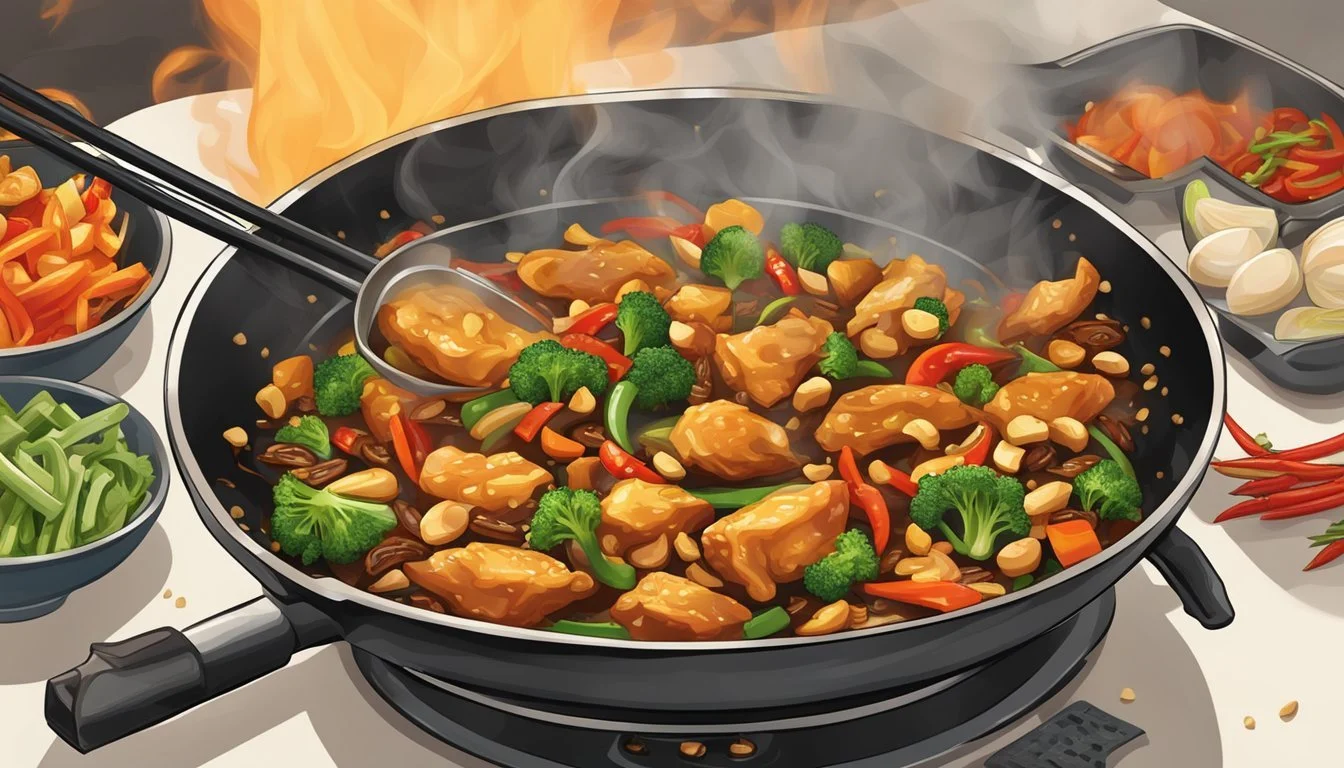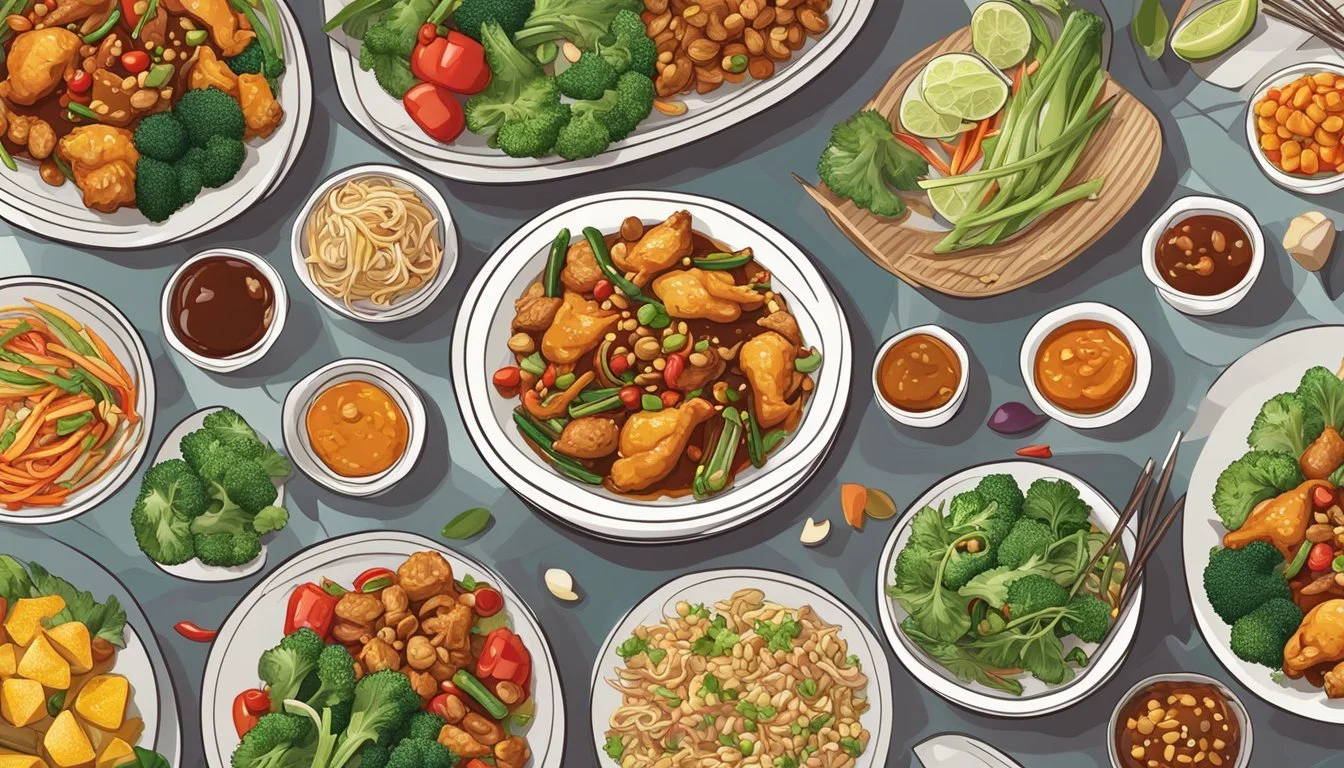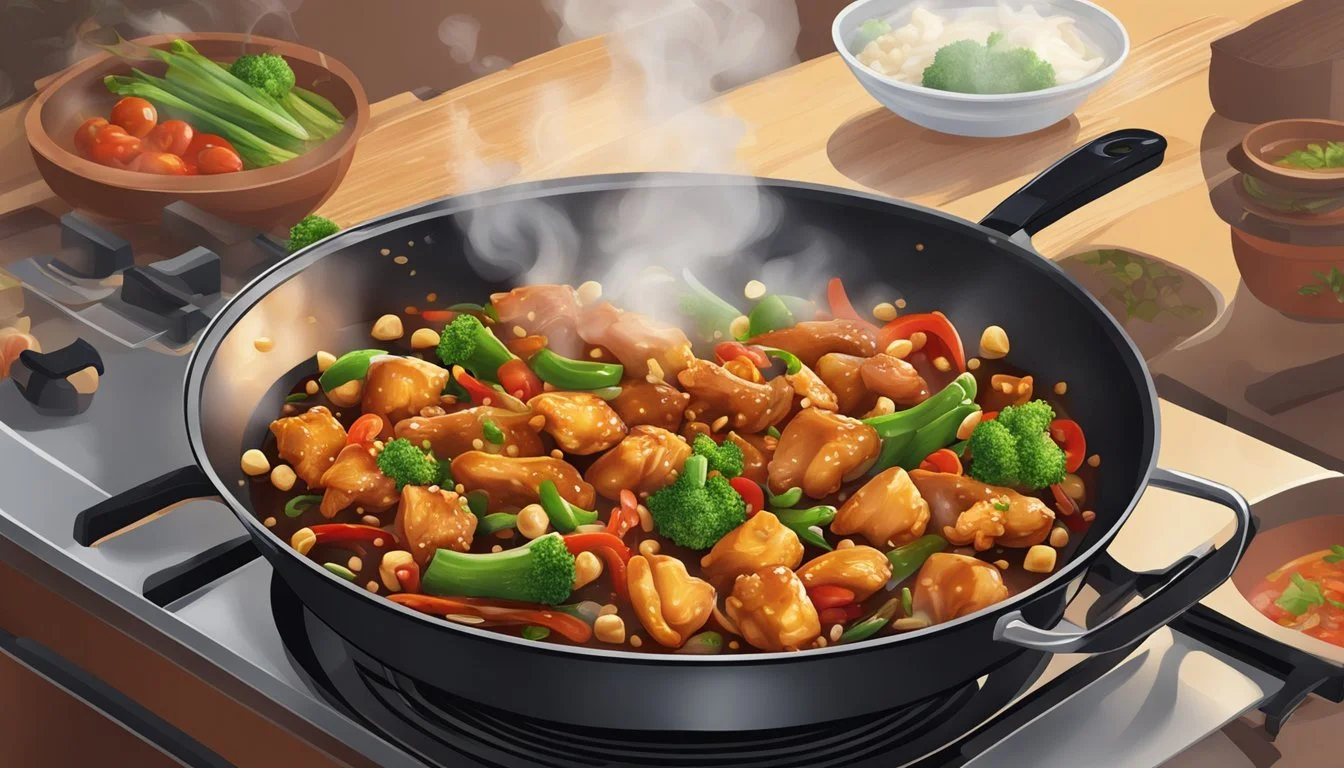Best Way to Reheat Kung Pao Chicken
Ensuring Crisp Veggies and Spicy Flavor
Kung Pao Chicken is a popular Sichuan dish known for its bold flavors, combining spicy, sweet, and salty notes with a satisfying crunchy texture from the vegetables. While it is best enjoyed fresh, it's not uncommon to have leftovers that require reheating. The challenge lies in restoring the dish to its original glory without compromising on the crispness of the vegetables or the potency of the sauce.
Reheating Kung Pao Chicken properly is essential to prevent it from becoming soggy or bland. The key is to employ a method that evenly warms the chicken and sauce while preserving the texture of the vegetables and keeping the spices lively. Using the right techniques ensures that the reheated dish mirrors the freshness and vibrancy of when it was first cooked, making it almost as enjoyable as the initial serving.
Understanding Kung Pao Chicken
Kung Pao Chicken is a classic Chinese Sichuan dish that is as rich in flavor as it is in history. With its perfect blend of savory, sweet, and spicy elements, mastering the balance of its components is key to its authenticity.
Ingredients Breakdown
To honor the dish's heritage, one must understand the fundamental ingredients that create its distinctive taste. A traditional Kung Pao Chicken includes:
Protein: Diced chicken is the staple, often marinated to enhance moisture and flavor.
Vegetables: Commonly used vegetables include scallions (green onions), bell peppers, and zucchini.
Aromatics: Garlic and ginger are essential for their pungency and warmth.
Nuts: Peanuts add a crunchy contrast to the dish's texture.
Seasonings: Sichuan peppercorns induce a tingling sensation, while a balanced mix of soy sauce, vinegar, and sugar create the base for the sauce.
Heat: Dried chilies or chili flakes provide the signature spice.
Oil: Used for cooking, it's important to choose one with a high smoke point.
Historigraphical Significance
Kung Pao Chicken, known as "Gong Bao" or "Kung Po," originates from Sichuan Province in China and is named after a Qing Dynasty official. The dish's hallmark is its ability to combine heat from dried chilies and Sichuan peppercorns with the cooling effect of ginger and peanuts. Introduced to Western palates by Chinese restaurants, Kung Pao Chicken has evolved in various regions, often adapting to local tastes while maintaining its Sichuan roots. This historical dish serves as a testament to the culinary diplomacy of China's diverse flavors.
Preparations Before Reheating
Reheating Kung Pao Chicken starts well before turning on the stove; it hinges on how the leftovers are stored and ensuring food safety measures are met.
Storage Tips
When storing leftovers, it’s crucial to use an airtight container to preserve the freshness and prevent the absorption of odors from the refrigerator. For best results, one should refrigerate the Kung Pao Chicken within two hours of cooking to prevent bacterial growth. The ideal storage method involves compartmentalizing components if possible:
Vegetables: Store them separately to maintain their crispness.
Sauce: Keep in a separate glass container to avoid sogginess.
If freezing, ensure containers are freezer-safe and leave a small gap to allow for the expansion of food as it freezes.
By keeping the sauce and vegetables apart, reheating will allow for adjustments to maintain the desired texture and flavors.
Safety Measures
Before reheating, always check that the leftovers have not spoiled by inspecting for any off-smells or signs of mold. Use a thermometer to ensure that the chicken reaches an internal temperature of 165°F (74°C) during reheating to make it safe for consumption. Here's the breakdown:
Temperature Check: Use a food thermometer to check the internal temperature.
Heating Method: Choose either a stovetop or an oven method based on preference and whether you are reheating roasted or cut chicken breast.
By adhering to these safety measures, the reheated Kung Pao Chicken will be both safe to eat and delicious, with a spicy sauce and juicy chicken enhanced by the original cook time's flavors.
Reheating Techniques
When reheating Kung Pao Chicken, the goal is to maintain the crispness of the vegetables and the spiciness of the sauce. There are various methods to achieve this, each requiring specific steps to ensure the dish retains its original flavor and texture.
Stovetop Method
For the stovetop method, one starts by heating a large skillet over medium heat. It's advisable to add a small amount of oil to the skillet to prevent sticking. The Kung Pao Chicken should then be added to the skillet with a little water if necessary to create steam. One should cover the skillet with a lid to trap moisture and reheat the dish, frequently stirring to ensure even heating without overcooking the vegetables.
Microwave Strategy
Microwaving is faster but requires careful attention to prevent the chicken from becoming rubbery. To microwave, place the Kung Pao Chicken in a microwave-safe dish and cover it with a microwave-safe lid or vented plastic wrap. One should add a splash of water to aid with moisture and heat on a medium setting in short intervals, stirring between each to evenly distribute the heat.
Oven Approach
The oven approach involves preheating the oven to 350°F (175°C). Kung Pao Chicken should be placed in a glass or ceramic baking dish. To retain moisture, cover the dish with aluminum foil. The dish should then bake in the oven until the chicken is thoroughly heated, which typically takes about 15-20 minutes.
Alternative Methods
Further reheating options include utilizing a toaster oven or an air fryer. A toaster oven can be used similarly to a conventional oven with adjustments for smaller volume. For an air fryer, it's recommended to reheat at a lower temperature to avoid drying out the dish. In both cases, one should monitor closely to ensure the leftovers regain the desired temperature without sacrificing their crispness.
Maintaining Texture and Flavor
When reheating Kung Pao Chicken, it's crucial to preserve the crispness of the vegetables and the richness of the spicy sauce. Certain techniques can ensure that the vegetables do not turn soggy and the sauce maintains its intended flavor profile.
Vegetable Crispness
Vegetables such as bell pepper, broccoli, green onions, and celery are integral to Kung Pao Chicken, adding both crunch and nutrients. To preserve their texture:
Stir-frying - Quickly stir-fry the vegetables over high heat using a small amount of oil. This method retains crispness and freshness.
Steaming - If the vegetables are separate from the chicken and sauce, light steaming for a couple of minutes will warm them through without overcooking.
Ensuring Spicy Sauce
The sauce of Kung Pao Chicken gets its kick from chili peppers, along with a balance of sweet from sugar and savory from soy sauce. To maintain the sauce's complexity:
Thickening agents: Utilize a slurry of water and cornstarch to adjust the consistency if the sauce has become too thin.
Reheat gently: Heat the sauce on low heat, stirring frequently to avoid separation or burning, which can diminish the spicy and sweet elements.
Avoiding Common Pitfalls
Several common mistakes can spoil the quality of reheated Kung Pao Chicken:
Overcooking: Reheat only until the food reaches the safe temperature of 165°F, as overcooking can cause the vegetables to lose their crispness and the nuts to become soft.
Uneven heating: If using a microwave, stir the chicken and sauce at intervals to avoid cold spots.
Contamination: Use separate utensils for raw and cooked items to prevent any cross-contamination in the recipe.
By following these targeted techniques, the vegetables in Kung Pao Chicken will stay crisp and the sauce will retain its bold, spicy flavor during the reheating process.
Adjusting the Recipe
When reheating Kung Pao Chicken, one might wish to adjust the recipe to cater to individual taste preferences, dietary requirements, or simply to enhance flavors and maintain texture. The following subsections will detail how to tweak ingredients and boost flavors effectively.
Ingredient Modifications
To keep vegetables crisp during reheating, one might consider reheating them separately from the chicken and sauce; this prevents overcooking. For those preferring a different protein, beef, shrimp, or tofu can be substituted for chicken. One can also add mushrooms or additional veggies like bell peppers or snap peas for more variety and texture.
When incorporating noodles or rice, ensure they are reheated separately to maintain their distinct textures. Rice should be moistened with a bit of water before reheating to prevent drying out. If utilizing noodles, a quick toss in a pan may revive their texture.
Flavor Enhancements
Adding a few dashes of sesame oil can rejuvenate the dish’s aroma and give it a fresh-from-the-wok taste. A sprinkle of black pepper can revive the spiciness if it has mellowed after storage. If you find the sauce lacking, a touch of hoisin sauce could reintroduce depth and sweetness.
For those who appreciate a more custom taste profile, consider adding variations like a pinch of chili flakes for extra heat, or a teaspoon of sugar for balance. Adjusting these elements can remarkably change the dish's flavor intensity without overpowering the original recipe's essence.
Complementary Side Dishes
When serving Kung Pao Chicken, selecting the right side dishes can enhance the flavors and provide a balanced meal. The following pairings range from traditional to unique, and include options suitable for various dietary preferences.
Traditional Pairings
Pairing Kung Pao Chicken with steamed white rice is a classic choice that offers a neutral backdrop, allowing the bold flavors of the dish to shine. For a healthier whole grain option, brown rice provides a nuttier taste and additional fiber. Noodles, whether wheat-based or rice noodles, also complement the spicy and savory notes of Kung Pao Chicken.
Health-Conscious Options
For those seeking low-carb or gluten-free alternatives, cauliflower rice serves as an excellent substitute for traditional rice. It's not only lower in calories but also provides an extra serving of vegetables. To accommodate a gluten-free diet, one can opt for tamari instead of regular soy sauce when preparing the side dishes.
Unique Accompaniments
Moving beyond the norm, one can introduce spicy enoki mushroom salad with garlic to the table, adding a crunchy texture and umami flavors that marry well with the spiciness of Kung Pao Chicken. For those looking for a greener option, a crisp Chinese zucchini salad dressed with garlic sauce, soy sauce, vinegar, and dried chilies can provide a refreshing contrast.
Expert Tips for Best Results
Achieving the perfect reheated Kung Pao Chicken, with its signature crispy vegetables and robust spicy sauce, is all about technique and timing. These expert tips are tailored to ensure that the flavors are preserved and the texture remains ideal.
Chef's Secret Techniques
Chefs often use dry-frying to preserve the crispness of vegetables in dishes such as Kung Pao Chicken. To employ this method at home:
Stir-frying: Reheat the chicken and vegetables by stir-frying over medium heat. This method helps retain the crunchiness of vegetables like green onions.
Separation: Reheat the sauce and vegetables separately to avoid soggy veggies. Combine them only when both components are adequately heated.
Serving Recommendations
For an exemplary Kung Pao experience, one must not overlook the details that make the dish stand out:
Sichuan Pepper: Enhance the flavor by garnishing with freshly ground Sichuan pepper after reheating to reintroduce its signature numbing spice.
Roasted Nuts: Serve with a handful of roasted peanuts or nuts added after reheating to ensure they retain their crunch and do not become rubbery.
Optimal Reheating Times
An optimal balance between temperature and time is crucial for the best reheated Kung Pao Chicken:
Total Time: Keep the total reheating time under 30 minutes to prevent overcooking.
Cook Time: If using an oven, preheat to 350°F (175°C) and bake for 10-15 minutes; on the stove, cook for 5-10 minutes while stirring frequently.
By adhering to these methods and timings, one can expect delectably warm Kung Pao Chicken that is as close to the original serving as possible.
Safety and Storage
When reheating Kung Pao Chicken, it's crucial to follow food safety guidelines and implement proper storage solutions to maintain the dish's quality and minimize the risk of foodborne illness. By doing so, one ensures that the vibrant flavor and texture of the dish are preserved.
Food Safety Guidelines
Reheating Kung Pao Chicken, or any dish for that matter, should be done with food safety in mind. To avoid bacterial growth, the reheated chicken should reach an internal temperature of 165°F. Use a food thermometer to check. If one is planning on reheating a meal that includes chicken breasts or thighs, these guidelines become especially pertinent due to their susceptibility to harboring bacteria:
Reheat only once: After the initial cooking, chicken should only be reheated one time to ensure food safety.
Thorough heating: Ensure that every part of the dish reaches the safe temperature.
Avoid room temperature: Never leave Kung Pao Chicken at room temperature for more than 2 hours.
Proper Storage Solutions
To maintain the integrity of Kung Pao Chicken for reheating, proper storage is key. Here are specific methods for storing this spicy delicacy:
Refrigeration: Store leftovers in an airtight container and refrigerate within two hours of cooking. Consume within 3 to 4 days.
Freezing: If one won't consume the Kung Pao Chicken within a few days, freezing is an option. Use an airtight container or freezer-safe bags, label with the date, and consume within 2 to 3 months for optimal quality.
Meal Prep: For those who meal prep, dividing the dish into portion-sized airtight containers can simplify future reheating. Add a little chicken broth before freezing to help maintain moisture.
By implementing these food safety and storage strategies, one can enjoy their Kung Pao Chicken with confidence that it is not only delicious but also safe to eat.
FAQs on Reheating Kung Pao Chicken
The process of reheating Kung Pao Chicken involves balancing the retention of its crisp vegetables and the boldness of its spicy sauce. This section addresses frequently asked questions to ensure leftovers are as enjoyable as when first served.
Addressing Common Concerns
Is microwaving Kung Pao Chicken a good option?
Microwaving Kung Pao Chicken is quick and convenient. For best results, place the leftovers in a microwave-safe dish, cover with a damp paper towel to help distribute heat and retain moisture, and microwave in short intervals, stirring in between. It’s essential to not overheat, as this can make vegetables soft and sauce flavors less distinct.
Will reheating Kung Pao Chicken on the stovetop keep the vegetables crisp?
Using a stovetop and a large skillet can help maintain the crispness of vegetables. Heat the skillet over medium heat, add the chicken and a bit of oil to prevent sticking. Stir frequently to heat evenly while preserving the vegetable's texture.
Handling Leftovers Effectively
How should Kung Pao Chicken be stored for reheating later on?
Leftovers should be stored in a sealed container in the refrigerator. Separate the sauce from the chicken and vegetables if possible, to maintain their individual textures and flavors. This precaution aids in reheating each component to their best consistency and taste.
Troubleshooting Reheating Issues
My Kung Pao Chicken isn’t as flavorful after reheating; what can I do?
Flavors can dull over time, especially the spicy notes. When reheating, one can add a pinch of the original spices (like Sichuan pepper) to enhance the flavors. If the dish tastes too sour or sweet after reheating, adjust by adding a bit more sugar or vinegar, respectively, and stir well before serving.
What if the chicken dries out during the reheating process?
If the chicken starts to dry out, adding a small amount of water or broth can reintroduce moisture. It's important to add liquids sparingly and to heat only until the chicken is just heated through to avoid overcooking.







